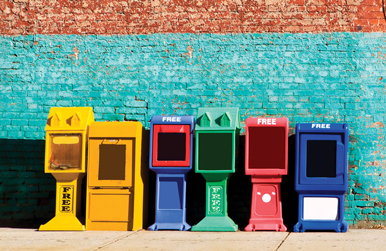
What’s black and white and in the red all over?
Local news has been languishing for decades as advertisers and readers alike move from print to digital. But according to a 2022 report from Northwestern University’s Medill Local News Initiative, the decline in community papers is moving at a faster clip in recent years. The US has lost more than a quarter of its newspapers since 2005 and is on track—at a pace of two a week—to lose a third by 2025. Today, one in five Americans—70 million people—lives in a “news desert,” with little or no access to local coverage about the city council, zoning commission, or high school football.
“It is a fundamental truth—not just for individuals, but for communities and cultures—that the stories we tell are as important as the air we breathe,” said Terence Samuel, vice president and executive editor of National Public Radio and a 2023 fellow with AU’s Sine Institute of Policy and Politics. “Think climate change is bad? The decline of local news is equally dangerous.”
Samuel kicked off this year’s Sine seminars on February 8 with Local News: Deserts, Oases, and Solutions, featuring Sarabeth Berman, CEO of the American Journalism Project (AJP). The 2023 cohort of fellows also includes Bill de Blasio, former New York City mayor; Doug Ducey, former Arizona governor; Alida Garcia, vice president for advocacy, FWD.us; Anna Deavere Smith, playwright, actress, and author; and Mimi Walters, a former US representative for California.
Samuel’s career has spanned the Philadelphia Inquirer, St. Louis News-Dispatch, US News and World Report, and the Washington Post, where he worked as politics editor for six years before joining NPR in 2017. But he got his start at a local paper: the Roanoke Times in southwestern Virginia, where he worked as a police reporter, monitoring the scanner during the night shift. “They handed me a county and said, ‘Go cover it,’” he recalled. “Bedford County became my county. I knew what people there cared about.”
One of his most formative experiences as a young journalist was covering the murder-suicide of a 90-year-old woman and her 74-year-old son. Through Samuel’s reporting, he revealed that the man, who had been his mother’s only caretaker, had been diagnosed with cancer and was worried about what would become of her if he died.
“I was at the church [for the funeral] and one of the sisters says [during the eulogy], ‘A lot of you think this is a tragedy, but it is, in fact, a love story,’ I’m like, ‘Wow, that’s my kicker,’” he said.
“The story ran on the front page of the Sunday paper—a big splash,” Samuel continued. “A few weeks later, one of the relatives said to me, ‘This was a really hard thing to talk about with family and friends, but we sent them your story and that made it easier.’ That’s what local reporting does: It helps you talk to your neighbors, it helps you understand your community, it helps you understand who you are. That was the story that convinced me that I wanted to do this kind of work.”
According to AJP, weekday newspaper circulation tumbled almost 50 percent, from 55.8 million households in 2000 to 28.6 million in 2018, and 40 of the 100 largest dailies now produce a print issue six or fewer times a week. There are now 1,800 communities across the country that have no access to local news; even those that still have a paper of record have lost so many reporters—60 percent of newsroom jobs have been slashed since 2008—that they struggle to provide basic, community-focused information about school board meetings or city council elections. According to an audit conducted by AJP, only 17 percent of stories in “local” papers are, in fact, local.
Layoffs are but one sign of an industry in crisis, Berman said. Communities that have lost a local paper have seen a decline in civic engagement, “meaning people are less likely to run for office and less likely to vote.” Without reporters holding public officials accountable, government spending increases; so too does polarization.
“[Historically] you would vote for the mayor on issues. You would vote for the school board on the issues. You wouldn’t really care if they’re a Republican or Democrat, you just want to know how they’re going to take care of your trash collection,” she said. “Now in communities that have a lost a local paper, people are [voting] right down the ticket.” It’s become, she said, a game of “are you on my team or not?”
Disinformation is also on the rise. “Where you used to go to your local newspaper, you now go on the internet [where] you don’t have reporters vetting facts and putting things in context,” said Berman, whose organization has invested $40 million in 37 digital newsrooms across the country, from Montana to Mississippi, and incubated new ones, like Atlanta’s Capital B, which centers the voices of Black residents.
“In so many parts of the country, we have a crisis of empathy; we’re not seeing each other as people,” Berman said. “It is through storytelling and the role that local news plays that we can begin to build that back.”